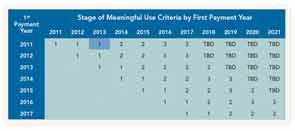
The Centers for Medicare and Medicaid Services (CMS) and the Office of the National Coordinator for Health Information Technology set forth a new timeline for attesting to Meaningful Use. Under the final rule, the first possible year of attesting to Stage 2 will be 2014. The final rule also outlines changes that will affect those providers who will attest to Stage 1 of Meaningful Use from 2013 and beyond.
Final Opportunity to Begin Attestation
Medicare payment adjustments are required by statute to take effect in 2015, and the last opportunity for providers to begin attesting for Meaningful Use is 2014. Providers who achieve Meaningful Use for the first time in 2014 will avoid the 2015 payment adjustment only if they are able to demonstrate Meaningful Use at least three months prior to the end of the calendar year. Eligible providers will also need to meet the registration and attestation requirements by October 1, 2014.
In order to allow time for providers to fully implement new Certified Electronic Health Record Technology (CEHRT), CMS introduced a three-month EHR reporting period regardless of the start year. In future years, providers who are not in their initial year of demonstrating Meaningful Use must meet criteria for 12-month reporting periods.
The Delay of Stage 2 Impacts Stage 1
Stage 2 was initially planned to begin in 2013, but the final rule issued in August 2013 delayed the start until 2014. Due to the delay in Stage 2, eligible providers who attested to Stage 1 of Meaningful Use in 2011 are permitted a third year at Stage 1. Providers who attest after 2011 will proceed as originally planned with a 90-day reporting period in their first year, and a 12-month reporting period in their second year before moving on to Stage 2 in their third year. (See chart below.)
Note that providers who were early demonstrators of Meaningful Use in 2011 will meet three consecutive years of Meaningful Use under the Stage 1 criteria before advancing to the Stage 2 criteria in 2014. All other providers would meet two years of Meaningful Use under the Stage 1 criteria before advancing to the Stage 2 criteria in their third year.
Stage 1 Changes: Exclusions, CQMs, and Measures
In previous years, exclusions to core and menu objectives were permitted that would allow providers to achieve Meaningful Use without having to meet objectives that fall outside the scope of their clinical practice. Beginning in 2014, qualifying for exclusion for a menu set objective will no longer reduce the number of menu set objectives a provider must satisfy to demonstrate Meaningful Use for Stage 1. For eligible providers who meet the criteria to exclude five or more menu set objectives, the provider must meet the criteria for all of the remaining objectives.
Clinical quality measures (CQMs) are no longer a core objective of Meaningful Use in 2014; however, eligible providers are still required to report on CQMs in order to demonstrate Meaningful Use.
Several Stage 1 measure revisions take effect beginning in 2014, including changes to computerized provider order entry, online access, and health information exchange testing.
Stage 2 Changes Taking Effect in 2014
Stage 2 of the EHR Incentive Program builds upon Stage 1 requirements by increasing thresholds for certain measures and introducing new technologies geared specifically toward increased electronic communication with patients on relevant health information. The expectation for Stage 2 is that providers who achieve Stage 1 will be able to demonstrate meaningful use of CEHRT for an even greater portion of their patient populations.
In Stage 2, CMS maintains the same core-menu structure for the program. Eligible providers must meet the measure or qualify for exclusion to 17 core objectives and three out of six menu objectives. Nearly all of the Stage 1 core measures were retained for Stage 2. There are also multiple Stage 1 objectives that were combined into more unified Stage 2 objectives with a subsequent rise in the measure threshold that providers must achieve for each objective. Several new objectives were introduced for Stage 2, and most of these were introduced as menu objectives for Stage 2.
In addition to core and menu measures, eligible professionals are required to report on specific CQMs in order to qualify for incentive payments and avoid payment adjustments. Eligible professionals must submit nine CQMs from at least three of the National Quality Strategy domains out of a potential list of 64 CQMs across six domains.
The Future of Meaningful Use
Stage 2 will change how providers use and share health information and will set the stage for Stage 3, which will focus on improved outcomes in quality, safety, and efficiency; clinical decision support; and patient self-management tools that support improved outcomes.
The ACR has resources available to help rheumatologists implement Meaningful Use in their practices. The implementation will call for the adoption of new processes and redefinition of roles, responsibilities, and tasks. This transformation brings the potential for substantial gains in the quality of care delivered and clinical and administrative efficiencies.
If you have any questions about Meaningful Use and ACR resources to help your practice, contact the ACR health information technology staff at [email protected].
